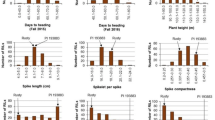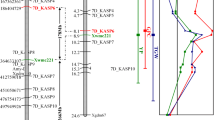Abstract
The introgression of desirable genes or alleles from the wild relatives of hexaploid wheat can be a valuable source of genetic variation for wheat breeders to enhance modern varieties. The UK Group 1 bread making variety Shamrock is an example where the introgression of genetic material from wild emmer (Triticum dicoccoides) has been used to develop a modern cultivar. A striking character of Shamrock is its unique viridescent colour compared to other UK wheats, a trait that coincides with a non-glaucous phenotype. A doubled haploid population segregating for the trait (Shamrock × Shango) was examined to map the location of Vir, and analyse any associated pleiotropic effects. The viridescence gene located to the distal end of the short arm of chromosome 2B. QTL analysis of productivity traits shows an association between Vir and a significant delay in senescence, resulting in an extension of the grain filling period. A stable yield QTL, accounting for up to a quarter of the variation in one case, was also identified at or near Vir, indicating significant yield benefits either by linkage or pleiotropy.





Similar content being viewed by others
References
Bassam B, Caetano Anolles G, Gresshoff P (1991) Fast and sensitive silver staining of DNA in polyacrylamide gels. Anal Biochem 196:80–83
Carver BF, Johnson RC, Rayburn AL (1989) Genetic analysis of photosynthetic variation in hexaploid and tetraploid wheat and their interspecific hybrids. Photosynth Res 20:105–118
Driscoll CJ (1966) Gene-centromere distances in wheat by aneuploid F2 observations. Genetics 54:131–135
Evans LT (1993) Crop evolution, adaptation and yield. Cambridge University Press, Cambridge, UK
Evans LT, Dunstone RL (1970) Some physiological aspects of evolution in wheat. Aust J Biol Sci 26:295–307
Fahima T, Röder M, Grama A, Nevo E (1998) Microsatellite DNA polymorphism divergence in Triticum dicoccoides accessions highly resistant to yellow rust. Theor Appl Genet 96:187–195
Garcia del Moral LF, Rharrabti Y, Villegas D, Royo C (2003) Evaluation of grain yield and its components in durum wheat under Mediterranean conditions. Agron J 95:266–274
Gerechter-Amitai ZK, Stubbs RW (1970) A valuable source of yellow rust resistance in Israeli populations of wild emmer, Triticum dicoccoides Koren. Euphytica 19:12–21
Grama A, Gerechter-Amitai ZK, Blum A (1983) Wild emmer as a donor of genes for resistance to stripe rust and for high protein content. In: Sakamoto S (ed) Proc 6th Int Wheat Genet Symp, Kyoto, Japan: Plant Germplasm Institute, University of Kyoto, 187–192
Jaccoud D, Peng K, Feinstein D, Kilian A (2001) Diversity arrays: a solid state technology for sequence information independent genotyping. Nucl Acids Res 29(4):e25
Jenson NF, Driscoll CJ (1962) Inheritance of the waxless character in wheat. Crop Sci 2:504–505
Kearsey MJ, Hyne V (1994) QTL analysis a simple ‘marker regression’ approach. Theor Appl Genet 89:698–702
Kushnir U, Halloran GM (1984) Transfer of high kernel weight and high protein from wild tetraploid wheat (Triticum turgidum/dicoccoides) to bread wheat (T. aestivum) using homologous and homoeologous recombination. Euphytica 33:249–255
Laurie DA, Reymondie S (1991) High frequencies of fertilization and haploid seedling production in crosses between commercial hexaploid wheat varieties and maize. Plant Breed 106:182–189
Monneveux P, Reynolds MP, Gonzalez-Santoyo H, Pena RJ, Mayr L, Zapata F (2004) Relationships between grain yield, flag leaf morphology, carbon isotope discrimination and ash content in irrigated wheat. J Agron Crop Sci 190:395–401
Nevo E, Gerechter-Amitai ZK, Beiles A (1991) Resistance of wild emmer wheat to stem rust: ecological, pathological and allozyme associations. Euphytica 53:121–130
Nevo E, Gerechter-Amitai ZK, Beiles A, Golenberg EM (1986) Resistance of wild wheat to stripe rust: predictive method by ecology and allozyme genotypes. Plant Syst Evol 153:13–30
Nevo E, Moseman JG, Beiles A, Zohary D (1985) Patterns of resistance of Israeli wild emmer wheat to pathogens. I. Predictive method by ecology and allozyme genotypes for powdery mildew and leaf rust. Genetica 67:209–222
NIAB (2002) Pocket guide to varieties of cereals, oilseeds and pulses—Autumn 2002. Cambridge Marketing Limited
Peng J, Korol AB, Fahima T, Roder MS, Ronin YI, Li YC, Nevo E (2000) Molecular genetic maps in wild emmer wheat, Triticum dicoccoides: genome-wide coverage, massive negative interference, and putative quasi-linkage. Genome Res 10:1509–1531
Richards RA, Rawson HM, Johnson DA (1986) Glaucousness in wheat: its development and effect on water-use efficiency, gas exchange and photosynthetic tissue temperatures. Aust J Plant Physiol 13:465–473
Snape JW, Foulkes JM, Simmonds J, Leverington M, Fish LJ, Wang Y, Ciavarrella M (2007) Dissecting gene × environmental effects on wheat yields via QTL and physiological analysis. Euphytica 154:401–408
Somers DJ, Isaac P, Edwards K (2004) A high-density wheat microsatellite consensus map for bread wheat (Triticum aestivum L.). Theor Appl Genet 109:1105–1114
Thomas H, Howarth CJ (2000) Five ways to stay green. J Exp Biol 51:329–337
Tsunewaki K, Ebana K (1999) Production of near-isogenic lines of common wheat for glaucousness and genetic basis of this trait clarified by their use. Genes Genet Syst 74:33–41
Verma V, Foulkes MJ, Worland AJ, Sylvester-Bradley R, Caligari PDS, Snape JW (2004) Mapping quantitative trait loci for flag leaf senescence as a yield determinant in winter wheat under optimal and drought-stressed environments. Euphytica 135:255–263
Wenzl P, Carling J, Kudrna D, Jaccoud D, Huttner E, Kleinhofs A, Kilian A (2004) Diversity Arrays Technology (DArT) for whole genome profiling of barley. Proc Natl Acad Sci USA 101:9915–9920
Acknowledgements
We would like to thank the Department for Environment, Food and Rural Affairs (DEFRA) and the Biotechnology and Biological Sciences Research Council (BBSRC) for their financial assistance through the LINK project “Investigating Wheat Functionality through Breeding and End-use” (FQS23). We are also grateful to Syngenta Crop Protection UK Limited and RAGT Seeds Ltd for their contributions to the phenotype data for this study. JIC is sponsored by the UK Biotechnology and Biological Sciences Research Council.
Author information
Authors and Affiliations
Corresponding author
Rights and permissions
About this article
Cite this article
Simmonds, J.R., Fish, L.J., Leverington-Waite, M.A. et al. Mapping of a gene (Vir) for a non-glaucous, viridescent phenotype in bread wheat derived from Triticum dicoccoides, and its association with yield variation. Euphytica 159, 333–341 (2008). https://doi.org/10.1007/s10681-007-9514-3
Received:
Accepted:
Published:
Issue Date:
DOI: https://doi.org/10.1007/s10681-007-9514-3




